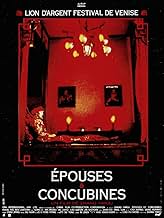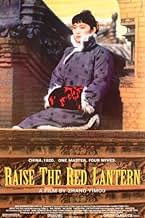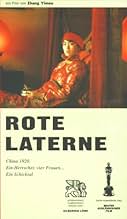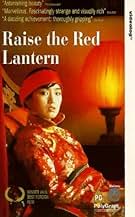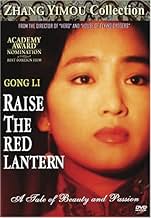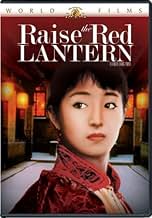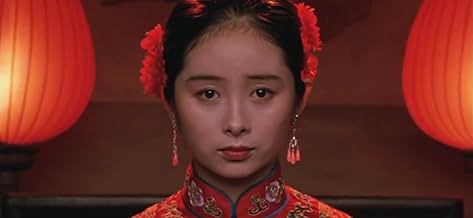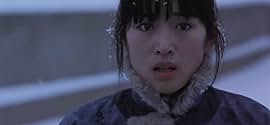CALIFICACIÓN DE IMDb
8.1/10
37 k
TU CALIFICACIÓN
Una mujer joven se convierte en la cuarta esposa de un señor rico, y debe aprender a vivir con las estrictas reglas y tensiónes dentro del hogar.Una mujer joven se convierte en la cuarta esposa de un señor rico, y debe aprender a vivir con las estrictas reglas y tensiónes dentro del hogar.Una mujer joven se convierte en la cuarta esposa de un señor rico, y debe aprender a vivir con las estrictas reglas y tensiónes dentro del hogar.
- Nominado a 1 premio Óscar
- 23 premios ganados y 15 nominaciones en total
Zengyin Cao
- Old Servant
- (as Zhengyin Cao)
Zhigang Cui
- Dr. Gao
- (as Zhihgang Cui)
Espérance Pham Thai Lan
- Kids - Concubines
- (sin créditos)
- Dirección
- Guionistas
- Todo el elenco y el equipo
- Producción, taquilla y más en IMDbPro
Opiniones destacadas
I can certainly understand why this film is so critically acclaimed. Raise The Red Lantern is one of the only Chinese movies I've seen, but I'll definitely admit that it's unusual to see a film this stylistically masterful come out of Hollywood (although it can happen -- The Thin Red Line, for example). A lot of what makes this film work is Zhang Yimou's outstanding directorial style; his use of color against bleak background is especially effective. It's his hypnotic visuals that keep you interested throughout the slow progression of the story. And the amazing acting by most of the performers doesn't hurt, either; everything feels completely real.
I think of this as one of those movies that you aren't supposed to enjoy; it shocks you, and leaves you just as disturbed as, considering the subject matter, you should be. The miserable story of Yan'er, the servant girl, is especially painful to watch, and the same goes for the unfolding of the last few scenes. But I think the fact that I was so unsettled by this movie probably just goes to show how well it gets its points across. And along with the remarkable acting and directing, that's definitely something to be respected.
I think of this as one of those movies that you aren't supposed to enjoy; it shocks you, and leaves you just as disturbed as, considering the subject matter, you should be. The miserable story of Yan'er, the servant girl, is especially painful to watch, and the same goes for the unfolding of the last few scenes. But I think the fact that I was so unsettled by this movie probably just goes to show how well it gets its points across. And along with the remarkable acting and directing, that's definitely something to be respected.
Just another, in a very, very long list of films that document the abuses and misery suffered by women - this time in 1920s China but take a decade of any country and you'll find a plethora of these films. It's a shame that such a huge amount of material exists in the first place, let alone that it continues to this day. That said, the visuals are spectacular, the acting sublime, it is a beautiful thing to behold and the message is well and truly received and understood: we know who is in charge!
Every frame of this film explodes with excellent acting, cinematography, music and art direction. I never thought I would see something so beautiful in a foreign film since Ingmar Bergman's work. This is by no means, an art film this is a human film, while holding an ethnic background these people portrayed in the film are all of us and is probably what we would call a fable on the cruelty of humanity. I'am disgusted to discover this film isn't on video or DVD in america. It seems as if its popularity has run thin since the 90's but this is a masterpiece people!
We Americans are accustomed to our fast moving world and our equally fast paced movies but the older countries of the world have something very valuable to offer in cinema, if we can take some time, literally, to consider it. This movie brings that mature stateliness of the old world before our eyes in almost an indelible way.
Moving in a very slow and artfully calculated rhythm, one scene slides into another, each setting a perfect little painting that can almost distract the attention away from the action and the dialog. The story develops gradually, starting out as a situation that is completely unfamiliar to the viewer and progressing stepwise through increasingly familiar emotional territory until even the 21st century American knows exactly where things stand.
The story is absorbing and the comment on Chinese society is important in today's world, but the main interest for me is the mood of meditative quietude and the rather dreamlike atmosphere that is generated continually, until it saturates right through.
Moving in a very slow and artfully calculated rhythm, one scene slides into another, each setting a perfect little painting that can almost distract the attention away from the action and the dialog. The story develops gradually, starting out as a situation that is completely unfamiliar to the viewer and progressing stepwise through increasingly familiar emotional territory until even the 21st century American knows exactly where things stand.
The story is absorbing and the comment on Chinese society is important in today's world, but the main interest for me is the mood of meditative quietude and the rather dreamlike atmosphere that is generated continually, until it saturates right through.
10gbheron
"Raise the Red Lantern" is set at a Chinese baronial estate, the time, the 1920s. But, as the family-servant dynamics are placed on display, the viewer begins to feel it could be a thousand years earlier. The story is shown through the eyes of a young college-dropout played by Gong Li. Family misfortune has forced her into concubinage as the "fourth mistress" of the Chinese lord. A headstrong woman, her relationship with the lord's household, especially the other three mistresses, form the basis of the story. But it's telling is as important as the story itself. This is a beautiful, well-acted, well-directed movie. Slow-paced, it ingratiates itself with you, drawing you in deeper and deeper. I can't think of anything that warrants improvement. A masterpiece.
¿Sabías que…?
- TriviaFilmed at the Qiao Family Compound near the city of Pingyao. The complex is now open for tours, however, nowhere is there any mention of the film.
- ErroresAround 01:18:59, there is a lot of smoke in front of the third wife. And there is almost no smoke in front of the second one.
- Citas
The Third Concubine: Good or bad, it's all playacting. If you act well, you can fool other people; if you do it badly, you can only fool yourself, and when you can't even fool yourself, you just can fool the ghosts.
Selecciones populares
Inicia sesión para calificar y agrega a la lista de videos para obtener recomendaciones personalizadas
- How long is Raise the Red Lantern?Con tecnología de Alexa
Detalles
Taquilla
- Total en EE. UU. y Canadá
- USD 2,603,061
- Fin de semana de estreno en EE. UU. y Canadá
- USD 22,554
- 15 mar 1992
- Total a nivel mundial
- USD 2,603,061
- Tiempo de ejecución2 horas 5 minutos
- Color
- Relación de aspecto
- 1.85 : 1
Contribuir a esta página
Sugiere una edición o agrega el contenido que falta

Principales brechas de datos
By what name was Esposas y concubinas (1991) officially released in Canada in French?
Responda

